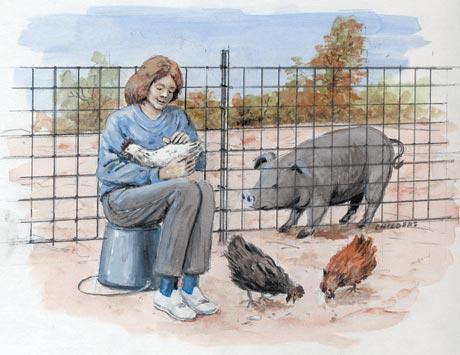 |
 |
| Issue #97 • January/February, 2006 |
There’s been a lot of talk in the mass media recently about Avian flu, also known as Bird flu and the H5N1 virus, and its potential to cause the next deadly pandemic among human populations. Its prime hosts are birds. If it jumps from domestic fowl, specifically chickens and ducks, to humans in a form that is easily transmissible among humans, it could kill several hundred million people, the major news media warns us.
Even President Bush seems worried. He recently outlined a plan to spend $7.1 billion to fight a flu pandemic, including $1.2 billion to buy an effective H5N1 Avian flu vaccine. There’s even talk of how to quarantine cities should the Avian flu pandemic strike America.
Tamiflu’s manufacturer can’t keep that antiviral flu drug on store shelves due to panic buying by an alarmed public. But is there really a reason to panic, or is this just another case of unnecessary hype by the news media?
This article tries to answer these and other questions posed by the possibility of a modern disease pandemic. It’s a bit lengthy and involved because, unlike the mass media that seems interested mainly in scaring the daylights out of readers by dwelling on the sensational aspects of the story, we want to give you the whole story.
20th century pandemics
Each year there’s an influenza (or flu) season that runs from about October to May. It starts, 30 to 60 million Americans come down with flu, and somewhere between 700 and 3,000 die of it. But every once in a while the flu is particularly virulent and becomes a pandemic, as it did on three occasions in the 20th century.
|
|
Many of us are old enough to remember the so-called Asian flu of 1957-58 that killed 70,000 Americans and an additional 1 to 4 million people worldwide. Eleven years later, the Hong Kong flu of 1968-69 killed 34,000 Americans and untold others around the world. It’s thought the reason the ’68-69 flu was not as deadly as the flu of ’57-58 was because the virus that caused the pandemic in the ’60s was similar enough to the virus that caused the earlier one that those who had been infected a decade before had some degree of built-in immunity to the new subtype.
But neither of these pandemics approached the doozie that was the so-called Spanish flu of 1918-19. It is against this pandemic that all modern pandemics are measured.
The Spanish flu killed some 500,000 to 675,000 Americans and at least 20 to 40 million (some estimates are 100 million) around the world. More people died of that flu in 18 months than died in the trenches, on both sides, during the four years of World War I. In fact, many of the war deaths of WWI were due to disease, and a large percentage of those were influenza deaths. The Spanish flu was, in part, responsible for the combatants ultimately laying down their arms in 1918, the last year of the greatest war the world had seen up to that time.
It’s estimated that 28 million of the roughly 100 million Americans living in 1918 contracted the Spanish flu, and about one of every 50 of those infected died. The death rate was even higher in some other parts of the world.
In terms of sheer numbers, the Spanish flu may have been the greatest pandemic of all time. Its only rivals are the Black Death, which killed about one third of Europe’s population (some 25 million people) between 1347 and 1351, and the mixture of epidemics caused by Old World diseases like small pox, yellow fever, measles, and others that swept through the native populations of the Americas starting in 1492, killing as much as 99 percent of a native population that may once have numbered more than 100 million people.
Kinds of flu viruses
There are three “types” of influenza viruses: Types A, B, and C. It is the Type A viruses, the viruses that live mostly among birds but can live in other animals, including man, that concern us.
Under Type A viruses there are at least 16 “subtypes,” classified according to the proteins that make up their outer shells. The viruses that caused the Spanish flu, the Asian flu, and the Hong Kong flu were each different subtypes of the Type A virus.
Within each subtype are strains caused by mutations in a virus subtype’s genes. It is the new subtypes and new strains, which are all part of the virus’s natural evolution, that can lead to pandemics because our immune systems do not recognize them.
|
Epidemics vs. pandemics
The Centers for Disease Control (CDC) classifies influenza outbreaks into two categories. The outbreaks we usually see from year to year are referred to as “seasonal outbreaks” or “epidemics.” They’re caused by new subtypes and new strains of influenza viruses that already exist. Influenza “pandemics,” on the other hand, are caused by virus subtypes or virus strains that are either new or haven’t been seen in a long time. They are viruses for which few, if any, people have resistance.
Because of the limited or nonexistent immunity to these new viruses, the disease can infect hundreds of millions, even billions, around the world. And when the virus is also particularly virulent, as was the virus that caused the Spanish flu, it is capable of causing millions of deaths.
Though the experts may disagree on how many people are going to die from influenza in any given year, many of them feel there will eventually be another great influenza pandemic that will rival the flu pandemic of 1918-19. They just don’t know when that’s going to happen or how bad it’s going to be. But they do have an idea of where it might start.
H5N1: the Avian flu virus
Today, there is a “new” influenza strain on the scenethe “H5N1” virus, and the disease it’s causing is being called Avian flu. Many call it Bird flu because it’s primarily a virus that infects birds. But it has on occasion jumped to humans. Early statistics indicate that when it does infect humans it is more than 50 percent fatal. That’s a very high mortality rate; the deadly Spanish flu killed only 2 percent.
Right now, almost all of the people who have contracted it got it from handling infected birds, though a few seem to have gotten it from human-to-human contact.
Despite those few cases that may have come from human contact, it appears H5N1, in its current form, is not capable of readily spreading from one person to another. And because of that, it hasn’t become what some experts feel could become the deadliest pandemic in human history.
Your immune system and mutating viruses
Why aren’t we always overrun by viruses? In a sense, we are. But our immune systems generate antibodies against viruses by identifying the proteins on the virus’s outer shell and developing antibodies against them. When a new flu virus invades our body, our immune system identifies it as an invader and, while we get sick with fever, sniffles, and coughs, our body learns to generate antibodies to fight it. Not only is this how the body cures itself, but the next time that same virus infects us, our immune system already knows how to rapidly generate more antibodies to kill it off before it can spread. It’s the reason we won’t get sick with the same type of flu more than once.
This is also why vaccines work. You have a dead virus injected into you, your body learns to recognize the proteins that make up its outer shell and, the same way it would have produced antibodies to fight a live version of the virus, it creates antibodies to destroy the dead viruses in the vaccine. Later, when live viruses of that subtype or strain do get into your system, your immune system immediately identifies them as something bad and knows how to quickly generate the antibodies needed to destroy them before they get a chance to successfully multiply and overwhelm your body.
That’s the good news. The bad news is that viruses are always mutating changing. Sometimes, the changes come about when one subtype of a virus exchanges its genetic material with another subtype and produces an entirely new virus with an outer shell of proteins our immune systems don’t recognize. This is called “antigenic shift.”
Viruses are also constantly undergoing what’s called “antigenic drift.” In this case, minor but random mutations in the virus’s genetic makeup alter it over time until our immune systems, which can recognize and manufacture antibodies to combat the virus in its old form, no longer recognize the virus’s new outer shell and cannot quickly respond to the “new” invader. When that happens, this “new” virus can begin to multiply and overwhelm our immune system before it can respond with new antibodies. You get sick. This can happen even if you had a case of the old virus or had been vaccinated against it. Your immune system just won’t recognize it if it’s changed enough.
A third way viruses can change is within the cells of animals. There is evidence that some viruses actually swap genetic material with their host’s cells, the same way they can swap genetic material with each other, thereby making the animal a vehicle for the viruses’ ongoing evolution. This is really another type of antigenic shift, but the important thing here is that it means that transmission of the virus from one member of that species to another member may become easier. If an influenza virus swaps genes with a human host, then when it spreads to other humans their immune systems will not recognize it until it’s done its damage, including the possibility of precipitating another pandemic.
The pig factor
Another fear is that this mixing will take place not in humans, but in pigs. That’s right, pigs. Pigs get the same flu viruses we do. With birds, in particular chickens, pigs, and people all closely cohabiting on farms in Asia, particularly in China, it’s feared that the next great pandemic will be from a virus like H5N1 shifting or drifting in the body of a pig and jumping from there to you and me. And if it does, the new virus could carry all of the deadly attributes of the H5N1 with its astronomical mortality rate. But there’s also another possible outcome, one more likely: in its altered form the virus could be a dud and not be deadly at all. How our bodies will react to these new viruses is always unpredictable, but usually we just fight them off like any other flu bug.

Why is it called the H5N1 virus?
There are many different subtypes and strains of Type A viruses. We classify the subtypes according to certain proteins on the surface of the virus. These proteins are hemagglutinin protein (the “H” in the subtype’s designation) or the neuraminidase (the “N”).
Hemagglutinin and neuraminidase proteins don’t just provide a handy way to name the viruses; they’re important to the virus because they’re how it interacts with the cells in our bodies, and they’re also part of the virus’s outer shell that your immune system “sees” when it’s trying to create antibodies to fight it.
The virus uses the hemagglutinin protein to attach itself to surface receptors on your body’s cells so it can get inside them. Once there, the virus takes over the cell’s genetic material and uses it to begin making copies of the pieces of itself. These pieces will later combine to make new viruses. That’s how viruses have babies.
Neuraminidase is an enzyme that breaks the bonds that hold new viruses your cells have helped create and frees them to infect ever more cells in your body. (See sidebar, What are viruses?) It may, in fact, so overwhelm your system that it could kill you. In the meantime, now that you’re infected, you will spread it to your spouse, your kids, your coworkers, and even that checker at Safeway when you hand her your money.
Other influenza viruses
Among the important influenza viruses that created pandemics in the 20th century were:
- the H1N1 virusthe killer Spanish flu virus of 1918-19
- the H2N2 virusthe Asian flu virus of 1957-58
- the H3N2 virusthe Hong Kong flu virus of 1968-69
|
The H2N2 and H3N2 viruses are thought to have come about after an exchange of avian and human influenza genesa case of antigenic shift.
Though they were deadly in their day, H1N1 and H3N2 are still present in the human population. However, most people now carry some level of immunity to them. The H2N2 is not currently circulating among humans.
Another virus subtype, H1N2, appears to be a “reassortment” of genes from the H1N1 and H3N2 viruses. It’s another case of antigenic shift that the medical community worries about. But in this case, the new virus produces ordinary flu symptoms and is not a virus to feara dud of sorts. This is what we hope happens if the H5N1 virus undergoes antigenic shift.
H5N1 in the past
Here’s some good news: the H5N1 virus isn’t new. It’s been around at least since 1959 when it was first discoverednot in Asia, but in Scotland. In the 46 intervening years it has not yet shifted or drifted into a form capable of jumping from human to human, which it will have to do if it’s to create a pandemic. This doesn’t mean it never will, but it also means it’s possible that it can’t. We simply don’t know enough about viruses to be able to predict what they’re capable of. (Some day, with gene sequencing and computers, we will probably be able to predict much of what they do and how they’ll affect us. But that’s the stuff of future science.)
Misleading media news
At the time of this writing, more than half the people who get Avian flu seem to be dying of it. The major media outlets love to report this since they are in the business of dwelling on bits of dramatic news in their ongoing effort to increase viewership and readership.
However, this figure is probably misleading. The problem when dealing with any figures early on in an epidemic or pandemic is that it’s likely that only the most severe cases are being identified.
When Severe Acute Respiratory
Syndrome (SARS) was making headlines and scaring us to death just a few years ago, it appeared as though its mortality rate was astronomical. But, as time went by, more and more mild cases were reported and its mortality rate became more realistic.
Getting stuck with unsold vaccine. Vaccines take nine months or more to develop. And a vaccine maker never knows which strain will be the strain going around “this” year. It’s a crapshoot. But it’s also money spent. If the flu season is a bust or if the vaccine maker guessed wrong, people may not get the shots, so the vaccine goes to waste. It doesn’t keep, and even if it did, it may not be effective against the strain going around next year. Liability lawsuits. Vaccines are more expensive to develop than most drugs. Vaccines are held to higher standards. We may accept that treatment for an otherwise fatal disease may have side effects. But we give vaccines to otherwise healthy people and expect zero side effects. The result is that anything perceived as a side effect often leads to lawsuits. They may be lawsuits with absolutely no basis in science. Keep in mind, a personal injury lawyer doesn’t have to convince a panel of scientists, but only 12 people off the street that he helped hand pick. (Witness the breast implant debacle that bankrupted Dow Corning, a suit with virtually no scientific merit. In scientific circles it was a joke, but in legal circles it was hailed as some kind of moral victory.) Patent protection. Several governments are saying they may just hijack the means of making treatments and vaccines without any indication they’d compensate the companies. If anyone thinks that’s not going to inhibit the future willingness of drug companies to develop new drugs, they’re not living in the real world. |
p>And as time progresses, it’s likely that more and more cases of Avian flu will be discovered to have been overlooked because they were mild. Once that happens, the mortality rate will be adjusted downward.
Here’s more good news: There are already instances of people who are showing antibodies for H5N1 virus, proving they had been “infected,” but who never showed any symptoms of having contracted flu. This is evidence there are people who are getting mild cases of the Avian flu virus without getting “sick.” This may be more common than we know.
Worst case scenario
Let’s say all our fears are realized and the H5N1 turns into something that is both highly deadly and highly contagious. How many people do the “experts” think it would kill? If it is a medium-level pandemic, some government planners in this country are saying as many as 200 million Americans could contract it, with 200,000 of them dying. Yet other “experts” say it could kill in excess of 16 million people in the United States alone.
The new U.N. coordinator for avian and human influenza, Dr. David Nabarro, originally said there could be anywhere from 5 million to 150 million deaths worldwide, though he later adjusted this to about 7½ million. But there are others who estimate that as many as one billion people could die worldwide.
It’s a guessing game. Pick a number or make up your own; one of them is bound to be right.
Finally, here’s what the CDC has to say: “Using death rates, hospitalization data, and outpatient visits, we estimated 89,000 to 207,000 deaths (in the U.S.); 314,000 to 734,000 hospitalizations; 18 to 42 million outpatient visits; and 20 to 47 million additional illnesses.”
In Asia
Though the H5N1 virus was first identified among birds in Scotland, there were no reported cases of it causing sickness in humans for decades. Finally, in 1997, 2001, and 2002, H5N1 viruses jumped to people and killed some of them.
In 1997, 18 people were diagnosed in Hong Kong as having contracted it. Six of them died.
In 2003, within a family from Hong Kong that had visited southern China, two cases were identified, one resulting in death.
Since 2003 it has jumped to people several times killing at least 65 of them. Forty of those deaths occurred in Vietnam where the virus has also killed tens of millions of birds.
Late in 2004, a low pathogenic avian influenza H5N2 was discovered on a breeding duck farm in the Republic of Korea. Though the 13,000 ducks on the farm seemed otherwise healthy, the flock was destroyed. The H5N2 virus is evidence that the H5N1 may be capable of antigenic shift. But it was a dud. It has not spread to people and it wasn’t harming the ducks.
In 2004, there were as many as 10 deaths attributed to the disease among several Far Eastern countries. And late in 2004, 45 tigers at a zoo in Thailand died after becoming infected with the H5N1 virus, apparently from eating raw chicken carcasses caretakers fed them. What made the report disturbing was that there was “probable horizontal transmission” among the tigers, meaning some of the tigers may have caught it from other infected tigers instead of from having eaten the chicken. However, judicious use of quarantining procedures and the subsequent cooking of the chickens used to feed them prevented any further spread of the disease.
In 2005 a man in Indonesia, along with his two daughters, died of H5N1, though none of them worked around poultry. The World Health Organization has no idea how these people became infected and says it cannot rule out the possibility that these cases were the result of human-to-human transmission.
Also, late in 2005, H5N1 was confirmed to have spread to birds in Romania, Turkey, and Russia.
There will be more reports like this in the future, but there is still no hard evidence the virus is capable of creating a pandemic among humans.
Where it will start
|
Earlier in this article I said we may not know when or how bad the next pandemic may be, but we know where it will probably start, and that’s in Asia, specifically China.
This is the worst of all possible scenarios not only because three quarters of China’s 1.3 billion people live on farms in close proximity to animals from which the virus is most likely to jump, but because of the Chinese health system. Simply put, it is both inadequate and corrupt. There are simply not enough doctors to cope with the enormous population, and because Chinese doctors, who are underpaid, often demand bribes before they’ll treat patients. For these reasons, many potential victims of flu either cannot or will not see doctors or go to hospitals. This means early cases of Avian flu are likely to be missed, to be unrecognized, or they’ll go unreported at a time when effective treatments and quarantining could stop its spread.
How a modern pandemic will differ from the past
In 1918-19, when the Spanish flu ran rampant through the world’s population, there were no transoceanic flights. All travel, especially travel across the Atlantic and Pacific Oceans, was painfully slow by today’s standards. But today, we have faster and universal air travel. People can get on a plane and cross oceans from Asia or Europe in just hours, compared to a week or more in 1918-19. And in almost any part of the world, people can and do drive between cities 1,000 miles apart in less than a day.
Increasing the danger is that people are contagious for about a week before they become symptomatic, and are contagious for about a week afterward. So, a person boarding a plane in Hong Kong or Paris may appear to be healthy while harboring the virus.
And, if a particularly virulent strain reaches our shores (or another one originates here), that person on the bus next to you may not be manifesting any symptoms while, at the same time, he’s breathing on you and, guess what? You go home, you’re infecting your family, and in about a week you and many in your household are sick.
In spite of this, it’s still not likely to spread as rapidly and as widely as the Spanish flu because, unlike the early 20th century, today we have better treatments, better sanitation, and quarantining would be easier.
How H5N1 currently spreads
Type A viruses are called avian viruses because they reside primarily in bird populations. They have jumped to some mammals, but they are primarily a bird disease.
Millions of domestic birds in Asia have died either as a direct result of the virus or in culling when the virus is detected in domestic flocks and they are slaughtered wholesale in an effort to contain the disease.
If the virus is to reach the United States, Canada, or Mexico, it will most likely arrive through the trading of commercial poultry and the illegal trade of exotic birds.
But another problem is the spread of the viruses in wild ducks. Ducks, both wild and domestic, seem to be able to harbor many avian viruses without becoming ill. But they can still pass it on. From these asymptomatic birds the viruses can spread to other birdsand, possibly, people.
The H5N1 virus is not likely to be spread to North America by wild or migratory birdsthis year. However, because of the migration patterns of some birds from Siberia, some of which cross the narrow Bering Sea to Alaska, it’s thought that, beginning next summer, there may be a mixing of indigenous shore birds and migrating waterfowl from Siberia.
Infected birds, whether sick or asymptomatic, are constantly shedding the virus in their feces, saliva, and mucous. This is how it is transmitted to other birds and, apparently, to humans working with them.
Either because of trade in commercial poultry, bird smuggling, or migrating birds, it’s probably just a matter of time before the virus shows up in both domestic and wild birds in North America. (However, see the sidebar, Pandemic flu and terrorism.)
If Avian flu arrives
For the symptoms and treatment of flu, see the sidebar titled, Getting and getting rid of the flu. If H5N1 jumps to humans, many of the symptoms will be the same as for any seasonal flu. However, with flu caused by the H5N1 virus, many of the symptoms are going to be more severe, and there are also major differences in how it attacks your body.
Unlike common cases of influenza that attack the upper respiratory syste; i.e., the bronchial tubes, nose, and throat, infection from H5N1 can go deeper into the lungs where they can do more serious damage. Victims have drowned in their own fluids, including blood, that fills their lungs. Those who survive often do so with lungs that are compromised and will be damaged for the rest of their lives.
If an actual H5N1 flu pandemic starts, avoid people who appear to have symptoms. In fact, avoid all people as much as you can. If I had children in school, I’d consider pulling them out and homeschooling them.
Over the years, BHM has advocated preparedness and having a preparedness kit. If you have a kit, this may be the crisis you’ve prepared for. If you don’t, use BHM’s EPSG book (page 66 and 99 of this issue) or some other, and start one. Minimizing your need to mix with others may save the lives of you and your family members.
I know the “health experts” are telling you not to stockpile flu drugs. If you want to be a good little boy scout, then don’t. But if I had access to them, I’d quietly put some away “just in case.” I’m not trying to save the world; I’m trying to save me and mine.
How Avian flu is treated
The good news is that antiviral medications currently used to treat other human flu viruses appear to be effective for the treatment of Avian flu. The bad news is that these drugs are in short supply. The worse news is that, as with treatments for any diseases, the pathogens are constantly evolving so as to become immune to the treatments.
|
Two new drugs that can be used to treat the flu are Tamiflu, an oral medication made by the Swiss pharmaceutical company, Roche, and Relenza, made by Glaxo Wellcome, Inc., which is usually administered by inhalation. The way they work is they interfere with the virus’s ability to replicate. This is important because it gives the body’s immune system a chance to develop antibodies to fight the disease before the virus can reproduce enough to overwhelm it. No drug can cure the flu. It just slows it down until your immune system can kick in.
Right now, neither company can produce their drugs fast enough to cope with a possible pandemic. (See sidebar, Why drug companies are hesitant to develop flu treatments and vaccines.) But in response to the media attention being focused on Avian flu, Roche, the sole manufacturer of Tamiflu, is negotiating with four other companies to license its manufacture. However, it may be for naught. There is evidence that some viruses are evolving to become resistant to their drug and that H5N1 may be resistant to it altogether.
Lastly, here’s a curious item in the news at this writing: researchers in South Korea claim kimchi, Korea’s spicy fermented cabbage dish, may help treat bird flu. Scientists at Seoul National University claim to have fed an extract of kimchi to 13 infected chickens and within a week 11 of them had recovered. The researchers admitted that this was no more than anecdotal evidence, and said if kimchi did have the effects they observed, they didn’t know why.
Is it true? I doubt it. It sounds like one of those quack folk cures. But it doesn’t matter, I love kimchi and any excuse to eat more of it is good enough for me. And if it saves my life in the meantime? Hey!
Vaccines
Two companies have created vaccines that appear to work against the H5N1 virus, but there are two problems: If an H5N1 pandemic were to start today, there’s not enough vaccine to go around. Also, neither vaccine may be effective against the virus health officials fear H5N1 may mutate into. In other words, you may get a vaccination, but if H5N1 mutates, it may be useless.
Cautious optimism
There were three influenza pandemics in the 20th century. The first was one of the greatest pandemics in human history. The way the news is being reported today, we seem poised on the brink of another.
However, though a future influenza pandemic is certainly possible, it’s not inevitable. And, if one does occur, it’s not even certain it will be caused by the H5N1 virus or one of its offshoots. H5N1 has been with us a long time without jumping species.
In fact, many experts feel that if there is another pandemic, it’s more likely to come from an antigenic shift or drift of a virus no one anticipates today.
So what should we do?
First, refuse to be panicked. News outlets and government agencies thrive on creating crises where none exist. Filter sensationalized reports through your common sense.
Second, stay alert. Know what’s happening in the country and the world so your common sense filter can tell you if a real pandemic emerges.
Third, and alwaysbe prepared. We may not be able to control virus mutations, migrating birds, drug companies, or supply lines, but we can take the steps necessary to protect ourselves and our families. Have enough food, water, and other supplies to ride out a future pandemic, or any other disaster.
|
|















